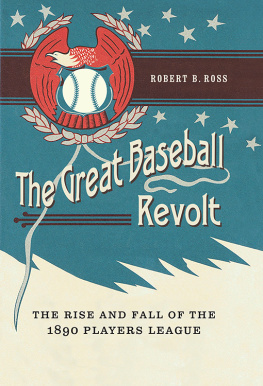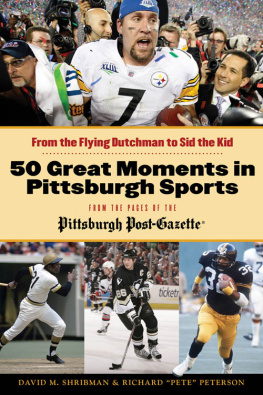
Also by RONALD T. WALDO
AND FROM MCFARLAND
Honus Wagner and His Pittsburgh Pirates: Scenes from a Golden Era (2015)
Pennant Hopes Dashed by the Homer in the Gloamin: The Story of How the 1938 Pittsburgh Pirates Blew the National League Pennant (2013)
The Battling Bucs of 1925: How the Pittsburgh Pirates Pulled Off the Greatest Comeback in World Series History (2012)
Hazen Kiki Cuyler: A Baseball Biography (2012)
Fred Clarke: A Biography of the Baseball Hall of Fame Player-Manager (2011)
The 1902 Pittsburgh Pirates
Treachery and Triumph
Ronald T. Waldo

McFarland & Company, Inc., Publishers
Jefferson, North Carolina
LIBRARY OF CONGRESS CATALOGUING DATA ARE AVAILABLE
BRITISH LIBRARY CATALOGUING DATA ARE AVAILABLE
e-ISBN: 978-1-4766-1506-6
2015 Ronald T. Waldo. All rights reserved
No part of this book may be reproduced or transmitted in any form or by any means, electronic or mechanical, including photocopying or recording, or by any information storage and retrieval system, without permission in writing from the publisher.
On the cover: Clarence Ginger Beaumont, Kitty Bransfield, Jesse Tannehill and stadium Exposition Park, Pittsburgh (National Baseball Hall of Fame Library, Cooperstown, New York)
McFarland & Company, Inc., Publishers
Box 611, Jefferson, North Carolina 28640
www.mcfarlandpub.com
Acknowledgments
This book, like the five that preceded it, was a labor of love. And the hundreds of hours that go into the research and writing of such a project can make it seem at times like a solitary affair. It is not. All along the way, people stepped forward to offer help of all kinds, some of it indispensable.
As always, I would like to extend thanks to the fine people at the Baseball Hall of Fame, and specifically to photo archivists Jenny Ambrose and Pat Kelly. As has been the case with all of my books, Jenny immediately responded to my queries, and Pat found the perfect photos to accompany the story I was hoping to tell. I commend them both for their professionalism and attention to detail.
I would also like to posthumously offer thanks to friend Lenny Langlois. Lenny always enjoyed reading my historical baseball perspectives, while I loved consuming his viewpoints about the current state of baseball, through the eyes of someone who once played the game. While I only knew Lenny for a couple of years, I would like to offer my gracious thanks for his positive influence, and hope he is commiserating with and getting a chance to pitch against some of the games greats on baseballs eternal diamond.
Most importantly, I would like to extend a sincere thank you to friend and fellow baseball writer Kathryn Gill, who supplied inspiration at various stages. At times during long days working on this book project, I would take a break to read Kathryns work, and on many occasions her writings about baseball rejuvenated me and got the creative juices flowing once again. Her passion, devotion and dedication to the game of baseball are both irrefutable and refreshing. Kudos to Kathryn for representing baseball so honorably.
I have to believe if Kathryn had been alive in 1902 while one of the greatest teams in baseball history was frolicking about Exposition Park wreaking havoc on the rest of the National League, she would have been connected to baseball in some fashion. I suspect Kathryn would have been a baseball scribe, passionately covering her beloved New York Highlanders once they entered the baseball scene in 1903, or possibly a pioneer years before Helene Hathaway Britton by owning that American League squad. I wholeheartedly believe that players like Fred Clarke and Honus Wagner from that golden baseball era who loved the game would have been proud to call Kathryn Gill their friend, just as I am today.
Preface
Throughout its rich history, the game of baseball has gone through many changes and seen numerous alterations to its rules, strategies and long-standing institutions. Major league baseball has also experienced many transformations to its organizational structure as franchises have come and gone, while modifications to the games top associations have been frequent. One such change occurred following the 1899 season as National League owners decided that contraction and consolidation should rule the day and usher in a new era of baseball that would be more profitable in the twentieth century. The twelve-team National League aggregation that had been established in 1892 changed to an entity containing eight franchises for the 1900 campaign as teams in Louisville, Washington, Cleveland and Baltimore were eliminated.
For many years, baseball fans from the blue collar, industrial city of Pittsburgh, Pennsylvania, had passionately rooted for their favorite team, even though these Pirates rooters experienced disappointment year after year. Pennants and championships were not part of the vocabulary in this town whose mills produced the vital steel that allowed America to grow. The closest Pittsburgh came to tasting pennant glory during the 1890s occurred when the Pirates finished in second place in the National League in 1893. After Pittsburgh secured a seventh-place finish in 1899, the prospects for improvement in 1900 finally looked promising due to the National Leagues contraction strategy.
Whether it was a stroke of good luck or just the result of conscientious negotiating between two baseball magnates, the Pirates franchise received a huge boost in December 1899, when players from the Louisville Colonels squad were traded to Pittsburgh. Louisville owner Barney Dreyfuss and Pittsburgh baseball magnate William Kerr hammered out an agreement that changed the Smoky Citys baseball landscape forever. After the acquisition of Fred Clarke, Honus Wagner, Tommy Leach and Deacon Phillippe, people connected to baseball now considered Pittsburgh a legitimate title contender whereas they had snickered in the past at such a suggestion.
Those Pirates rooters who had always believed that a National League pennant was a possibility were vindicated when this deal brought in star players and added Barney Dreyfuss to the teams ownership group. The Pittsburgh Pirates quickly became baseballs dominant team and were the first true baseball dynasty of the twentieth century, as pennants commemorating National League titles for 1901, 1902 and 1903 flew at the teams home diamond at Exposition Park. Nestled in Allegheny City on the North Side near downtown Pittsburgh, Exposition Park was the scene of baseball history in an area whose rich heritage is well known. Businessman H. J. Heinz and steel moguls Henry Phipps and Andrew Carnegie each resided in Allegheny at one time. Painter Mary Cassatt, writer Mary Roberts Rinehart, General George Robinson and actress Lois Weber were also born in this municipality where some of the early chapters regarding baseball history were written at Exposition Park.
While the 1903 Pittsburgh Pirates participated in the first modern World Series against the Boston Americans, it was the 1902 squad that defined that franchise during its glorious, three-year stretch dominating the National League. Cut from the same cloth as hard-working people from the citys steel mills and factories, players on that 1902 Pittsburgh Pirates squad put everything on the line each day as they aspired to become one of the greatest teams in baseball history. The end result was a record-breaking campaign which saw that team establish a National League record for victories in a season. By reaching such lofty standards, the 1902 Pittsburgh Pirates also confirmed their legitimacy in any future debates regarding the greatest teams in baseball history.
Next page













